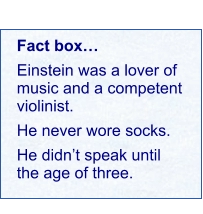
SuperFast Biography of Albert Einstein


Quick and easy summaries of relativity and related subjects
Albert Einstein, born on March 14, 1879, in the city of Ulm, Germany, was a theoretical
physicist who revolutionized scientific thought. His parents were secular, middle-class
Jews. He had one sister, Maria (who went by the name Maja), born two years after
Albert. He moved to Switzerland in 1895, forsaking his German citizenship the
following year at the age of 16. Best known for developing the Theory of Relativity, he
also made important contributions to quantum mechanics.
Einstein’s fascination with science began at age five when he was mystified by the
invisible forces that could deflect a compass's needle. At age 12, he discovered a book
of geometry, which he devoured, calling it his “sacred little geometry book”.
Special Relativity - A short overview and some of its consequences
E = mc
2
Basics - The basics and meaning quickly and easily explained

In 1905, often described as his annus mirabilis (year of miracles or wonders), Einstein
published four groundbreaking papers:
Outlining the theory of the photoelectric effect - the emission of electrons from a
material, typically a metal, when it absorbs electromagnetic radiation such as
light.
An explanation of Brownian motion - the random motion of particles suspended
in a liquid or a gas, caused by collisions with fast-moving atoms or molecules.
The Special Theory of Relativity - Which revolutionizes our understanding of
space and time.
Deriving the formula E = mc
2
- Which demonstrates that mass and energy are
equivalent to each other.




For much of the last phase of his academic life, Einstein worked on two endeavors that
proved ultimately unsuccessful. Firstly, he fought a long rearguard action against
quantum theory’s introduction of fundamental randomness into science’s picture of the
world, famously objecting that "God does not play dice". Secondly, he attempted to
devise a unified field theory by generalizing his geometric theory of gravitation to
include electromagnetism. As a result, he became increasingly isolated from the
mainstream of modern physics.
Widely held to be one of the greatest and most influential scientists of all time, he died
on April 18, 1955, in Princeton, New Jersey, U.S. He married twice and had three
children.
Suggested further reading:
Advertisement

SuperFast Biography
Albert Einstein
[ Special Relativity ] [ General Relativity ] [ Einstein ] [ Time Dilation ]
[ Black Holes ] [ Twin Paradox ] [ Time Dilation Formula ]
[ Special Relativity ] [ General Relativity ] [ Einstein ] [ Time Dilation ]
[ Black Holes ] [ Twin Paradox ] [ Time Dilation Formula ]
Advertisement

Quick and easy summaries of relativity and related subjects






Albert Einstein, born on March 14, 1879, in the city of Ulm,
Germany, was a theoretical physicist who revolutionized scientific
thought. His parents were secular, middle-class Jews. He had
one sister, Maria (who went by the name Maja), born two years
after Albert. He moved to Switzerland in 1895, forsaking his
German citizenship the following year at the age of 16. Best
known for developing the Theory of Relativity, he also made
important contributions to quantum mechanics.
Einstein’s fascination with science began at age five when he was
mystified by the invisible forces that could deflect a compass's
needle. At age 12, he discovered a book of geometry, which he
devoured, calling it his “sacred little geometry book”.
SuperFast Biography of Albert Einstein
In 1905, often described as his annus mirabilis (year of miracles
or wonders), Einstein published four groundbreaking papers:
Outlining the theory of the photoelectric effect - the emission
of electrons from a material, typically a metal, when it
absorbs electromagnetic radiation such as light.
An explanation of Brownian motion - the random motion of
particles suspended in a liquid or a gas, caused by collisions
with fast-moving atoms or molecules.
The Special Theory of Relativity - Which revolutionizes our
understanding of space and time.
Deriving the formula E = mc
2
- Which demonstrates that
mass and energy are equivalent to each other.

For much of the last phase of his academic life, Einstein worked
on two endeavors that proved ultimately unsuccessful. Firstly, he
fought a long rearguard action against quantum theory’s
introduction of fundamental randomness into science’s picture of
the world, famously objecting that "God does not play dice".
Secondly, he attempted to devise a unified field theory by
generalizing his geometric theory of gravitation to include
electromagnetism. As a result, he became increasingly isolated
from the mainstream of modern physics.
Widely held to be one of the greatest and most influential
scientists of all time, he died on April 18, 1955, in Princeton,
New Jersey, U.S. He married twice and had three children.
Suggested further reading:
Special Relativity - A short overview and some of its
consequences
E = mc
2
Basics - The basics and meaning quickly and
easily explained
[ Special Relativity ] [ General Relativity ] [ Einstein ]
[ Time Dilation ] [ Black Holes ] [ Twin Paradox ]

[ Special Relativity ] [ General Relativity ] [ Einstein ]
[ Time Dilation ] [ Black Holes ] [ Twin Paradox ]









